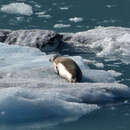Conservation
provided by EOL authors
The common seal is present in the eastern Atlantic region with its subspecies Phoca vitulina. It is regularly distributed throughout the entire marine Baltic region and in the marine Atlantic region from the Unite d Kingdom and Ireland to mainland European coasts from Sweden and southwards to France (Brittany) and occasionally as far south as northern Portugal. The Baltic population was close to e x tinction in the 1970s and wide spread declines have occurred in the United Kingdom , Kattegat and Skagerrak , and Wadden Sea populations. The species is vulnerable to fishery bycatch, culling, high pollution loads, disease events, and disturbance to haul out are as. The overall conservation status in the marine Atlantic region is ‘unfavourable -inadequate’ and dictated largely by the status (decre asing trend and population numbers be low the reference values) of the United Kingdom population which represents more than 50% of the marine region’s population. In the Baltic on the other hand, the overall assessment is ‘unfavourable-bad’ due to the status of the Swedish population which re presents almost half of the Baltic population. The species is listed as ‘least concern’ in the IUCN Red List of threatened species. The Conservation of Seals Act, 1970, provides a closed season for the Common seal during its pupping season. During this time, it is illegal to kill or take seals without a licence. There is also provision for giving complete protection to seals at al times, if neccesary. During the close season, a license is required to handle seals unless they are sick or injured (SMRU, 2004). The Baltic and Wadden Sea populations are listed under the Bonn Convention (Appendix II).

